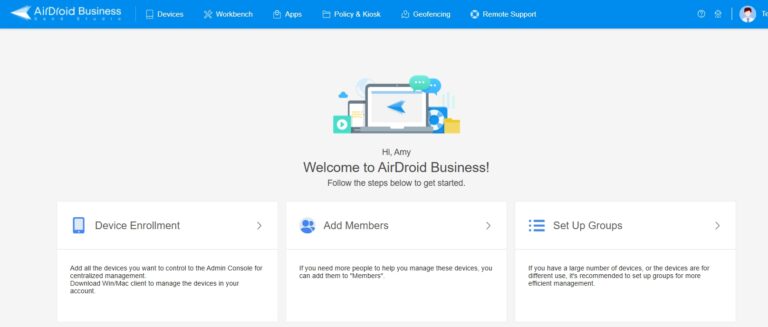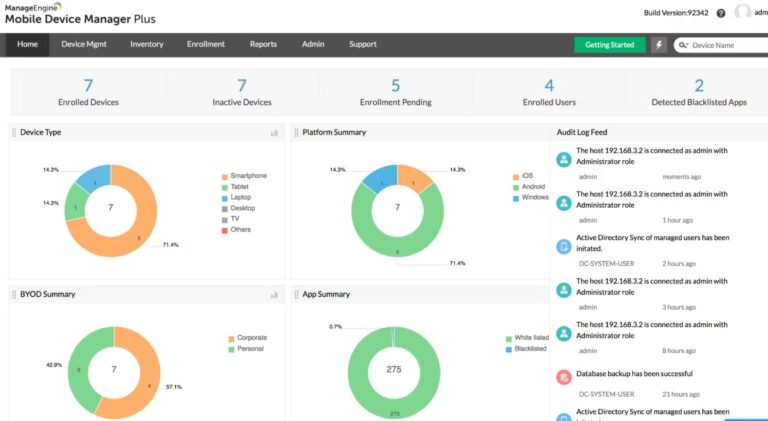Enterprise Mobility Management: Must-Know Insights for Businesses
1What is Enterprise Mobility Management
Enterprise mobility management (EMM) is a comprehensive approach to managing an organization's mobile devices, applications, and data. It couples mobile data management (MDM) with app and content management to streamline everything.
EMM often includes:
- Identity and Access Management (IAM): the management of digital entities
- Mobile Application Management (MAM): managing the lifecycle of applications
- Mobile Device Management (MDM) monitor, manage, and secure mobile devices from one central dashboard
- Mobile Content Management (MCM): the secure management of content accessed through mobile devices
According to TechTarget, EMM is on its way out. While it’s served as a groundbreaker for mobile device management, with everything tech-based, it’s almost at the end of its shelf-life. The reason for this is the uptake of Unified Enterprise Management (UEM), which covers not only mobile devices but desktops, networks, and everything Internet of Things (IoT). We’ve noticed that many EMM vendors are switching to UEM. In fact, Gartner no longer has a category for EMM, and even though G2 still retains it, we suspect it’ll be all UEM in the future.
For now, EMM is still providing businesses with some excellent mobile management. Here are some of its key features:
2Key Features
Device Management
We’ve watched EMM grow from managing a couple of mobile devices to vast numbers.
Over time, its features have expanded to allow IT admins to perform many tasks from a central dashboard. These include:
● Configure Wi-Fi settings
● Enforce security policies
● Manage device compliance
● Tracking inventory
● Managing device enrollment
● Applying policies for device usage and access
What we love most about an EMM's device management features is its remote monitoring function. This allows IT staff to know, at a glance, where every device on the network is, its status, and whether it requires maintenance or updating.
Security
Mobile data security is crucial for all of us. EMM is exceptionally helpful here, as it implements comprehensive security measures for corporate data. Some of the ways it does this are with features like data encryption and remote wipe. EMMs allow IT staff to create access controls to protect sensitive information from unauthorized access.
Compliance is important for us, too, and it’s made easier with EMM solutions. IT teams can ensure that devices meet security standards and policies by managing user identities and access privileges. This way, EMM minimizes any risks associated with data breaches and device loss.
Application Management
The biggest security risk of mobile devices is applications (apps). Hackers can easily access them, steal sensitive data, or cause device issues. Smart organizations will have an allowlist of acceptable apps, and EMMs can help manage those.
By ensuring that only approved apps are made available to device users, the chance for hackers to get in is narrowed. Even more advanced features include controlling app access and enforcing usage policies.
EMMs also allow IT teams to remotely install or uninstall apps, manage permissions, and monitor their usage to optimize performance and security.
3Top 3 EMM or Vendors
For organizations that want to monitor and manage mobile devices, EMM and UEM are still the best choices; here are three that we like:
1AirDroid Business

Reason for recommendation: AirDroid is ranked by G2 as the 1st Easiest To Use in Enterprise Mobility Management software and the 2nd best EMM tool.
Usability score: 9.7 far exceeds other products.
Strengths and weaknesses: Reviewers love how easy AirDroid is to set up and use, allowing IT teams to get stuck into the processes. Some IT experts feel it could be more customizable at a high tech level.
Level of technical support and service: comprehensive help database, email, and live chat support during business hours.
Price: AirDroid charges per device and offers four packages based on the features required. It starts at as little as $12 per device.
Reviews: 4.9/5.0
Key features:
- Remote control and access: IT admins can control and access any device from a centralized dashboard. They can perform actions like remote rebooting. In the case of troubleshooting an issue, they can take control of the device from the user and perform any required maintenance
- Automated enrolment and deployment: simplified process for speedy onboarding
- Device monitoring: real-time alerts if a device fails or is removed from a dedicated location
- Kiosk mode: IT teams can lock a device into kiosk mode, ensuring only the app(s) or websites required to perform specific functions can be accessed.
- Remote wipe: if the device is lost or stolen, sensitive data is wiped
- App-level encryption: security protocols can be set at the app level
- Compliance management: enforce strict security protocols to meet regulations
- Automatic updates: can be scheduled and in bulk, so every device remains up to date
- Usage monitoring: reports showing how every device functions help IT admin identify issues.
1. Device Management:
2.Security:
3. App Management:
What is Android MDM & 5 Best Android MDM Solutions
2 Jamf Pro

Reason for recommendation: Jamf Pro has been designed to work with iOS, and we consider it the best for Apple devices.
Strengths and weaknesses: JamF Pro is excellent for managing Apple devices, and users especially love the self-service app deployment feature. However, the extensive features may be overwhelming for smaller organizations or those with limited IT resources.
Level of technical support and service: Comprehensive help database, user forums, email, and phone support.
Price: Jamf comes under a single pricing model based on the number of devices, but volume discounts may be offered. It starts at $495 per year for up to 50 devices.
Reviews: 4.8/5.0
Key features:
- Automated Device Enrollment: Jamf Pro integrates with Apple's Device Enrollment Program (DEP) to automatically register and configure devices.
- Remote Device Management: IT administrators can remotely manage devices, including locking, wiping, and configuring settings.
- Compliance Monitoring: By monitoring encryption, patch levels, and other security configurations, IT teams can ensure devices are compliant with organizational security policies
- Remote Wipe and Lock: To protect sensitive data in case of loss or theft, administrators can remotely wipe or lock devices.
- Self-Service App Deployment: Users can install approved apps from a self-service portal
- App Configuration and Updates: All app settings are managed from a central dashboard
1. Device Management:
2.Security:
3. App Management:
3ManageEngine Mobile Device Manager Plus

Reason for recommendation: The best EMM for cross-platform management
Strengths and weaknesses: We love that ManageEngine Mobile Device Manager Plus supports cross-platform devices, including iOS, Android, Windows, macOS, and Chrome OS. However, it does appear more complicated initially than the other two on our list and has a steep learning curve.
Level of technical support and service: Knowledge base, community forum, email, and phone support.
Price: Three pricing options tailored for each client. As prices are negotiated, it’s hard for us to get an exact price per unit, but an average appears to be $4 per device per year.
Reviews: 4.5/5.0
Key features:
- Automated Device Enrollment: This option is ideal for bulk device enrollment and includes support for Apple Business Manager and Android Zero-Touch Enrollment.
- Remote Troubleshooting: IT staff can remotely view and control devices, enabling real-time troubleshooting and support.
- Compliance Monitoring: Monitor device compliance with security policies, including passcode enforcement, device lock, and data encryption.
- Remote Wipe and Lock: To safeguard sensitive information in the event of a lost or stolen device, IT admins can remotely wipe or lock it.
- Silent App Installation: IT staff can remotely install applications silently on devices without user intervention.
- App Blacklisting/Whitelisting: IT Admins can restrict access to specific applications by blacklisting unwanted apps and whitelisting approved ones.
1. Device Management:
2.Security:
3. App Management:
4What Industry is Enterprise Mobility In?
Enterprise mobility management is used across various industries, not just the tech ones. Here are four other sectors where it’s needed and specific examples of why for each:
1Transport
Enterprise mobility is necessary in the transport industry, and it is one of the many industries that benefit from a complete mobility solution. In November 2023, DP World Australia fell victim to a cyberattack, halting operations across the country for three days and resulting in a backlog of 30,000 shipping containers. The company didn’t have an EMM in place, and hackers got in due to a critical IT vulnerability known as CitrixBleed.
2Education
Educational institutions hold significant amounts of sensitive data on students and teachers that they don’t want to get into the wrong hands. An example of why schools and colleges need EMMs in place is the incident at the University of California, San Francisco (UCSF) in May 2020. They suffered a ransomware attack and had to pay $1.16 million for their databases to be unlocked. The university didn’t have an EMM; worse, it had limited cybersecurity resources and outdated systems, making it an attractive target.
3Retail
The retail industry needs to deal with mobility devices as employees need to work in the field, and consumers prefer self-service kiosks. Mobile payment devices and digital signage are standard in the retail industry. EMMs need to be in place in the retail market, even more so where third-party vendors are involved. In November 2023, Target was hacked through compromised credentials from a third-party vendor, Fazio Mechanical Services. Approximately 40 million credit and debit card accounts and the personal information of about 70 million customers were compromised. Surprisingly, despite its size, Target lacked sufficient mobile and endpoint management solutions at that time that could have helped secure access points, especially where third-party vendors were connected.
4Medical
The use of mobile work devices among hospitals and medical organizations is on the rise. Data security is a priority for the privacy of patient personal details and business data as a whole. An example is an incident that happened with Change Healthcare. In February 2024, it was a victim of a ransomware attack by the ALPHV/BlackCat group, and the private data of over 100 million patients was stolen. Change Healthcare has an EMM in place but isn’t making use of some critical features like multi-factor authentication (MFA). It’s necessary to have an EMM in place and to be sure to enable crucial functions.







Leave a Reply.